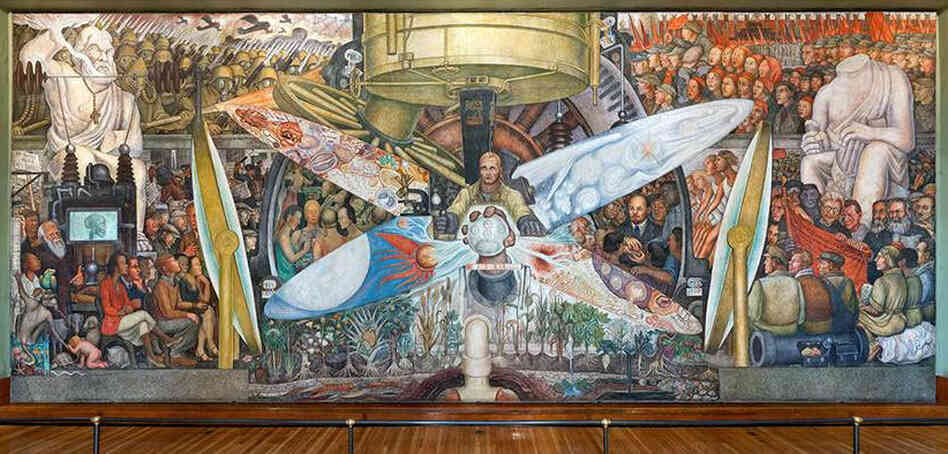
This Egyptian cosmetic box of the cupbearer Kemeni, ca. 1814-1805 B.C., is made of cedar, ebony, ivory and silver.
Metropolitan Musem of Art

Gold, porcelain, glass and steel compose this 18th-century necessaire from France.
This French mechanical table was intended for Madame de Pompadour. The designs depict her many interests, including gardening, painting, music and architecture.

This American worktable was made of satinwood and served as a sewing table and writing desk as well as a vanity.

A 1925 French dressing table shows off the Art Deco style.

The shapely drawers of Raymond Loewy's 1969 valet eliminated the need for hardware.
Ever since there have been puddles of water, human beings have gazed at their reflections.
Our need to primp and preen, whether we live in the Bronze Age or the Space Age, can be seen in a new exhibit at the Metropolitan Museum of Art in New York called Vanities: The Art of the Dressing Table.
Curator Jane Adlin offers a show that reminds us that while our vanity may ultimately be in vain, the instinct goes back a long way.
An Ancient Conceit
The exhibit begins with an inlaid cedar cosmetic box from Egypt's Middle Kingdom. The box, preserved in a Pharoah's tomb, contained stone ointment jars, perfumes, face paints and other potions. A hand mirror was made not from glass but of polished metal, with a wooden handle decorated with gold.
Found in 1910 by Howard Carter — who would later discover Tutankahemen's tomb — the box is 3,000 years old. Depicted on the drawer is a servant carrying a vessel, "a cupbearer, which was a high title," Adlin says.
Carter found the box in another tomb. "The fact that it was buried in their tomb with them shows how important it was as a means of showing status and their ability to adorn themselves," Adlin says.
The Egyptians weren't alone in their desire to adorn themselves. Through the ages, women have had their cosmetics and must-haves. The French called the ornate boxes that held them "necessaires."
"You would find tiny little perfume flasks, combs, nail files, tiny scissors," Adlin says. "These are clearly meant for the luxury market and were pieces that could have been owned by Madame de Pompadour or royalty, and were carried by their maids and brought out when the madame would ask for a comb."
Beauty, Style And The Unmentionable
These cosmetic boxes were portable. It wasn't till the late 1700s when finally, someone placed the box on a table and drew up a chair.
"By the mid-1800s, the dressing table has become this sort of extraordinary furniture piece," Adlin says. "It's the beginning of the era of the dressing table that we know of."
Madam de Pompadour, the Mistress of Louis XIV, was her era's style-setter. A painting shows her at her vanity table with her mirror, makeup brush, and compact, wearing a low-cut gown. The preening went on for hours. She'd receive visitors as she put on her makeup.
"She had incredibly good taste, and hired only the most important, the most well-known furniture designers," Adlin says. "She was very cultured, and she created amazing furniture."
The exhibit includes exquisite combs, some decorated with precious gems, some made out of rubber, and some made out of ebony and ivory. But they were not all used for beauty alone.
"The interesting thing about the double-sided combs: the wide tooth is to comb hair, and the narrow end is to comb out the lice," Adlin explains.
The Vanities Of Men
What about men? After all, they groom too, especially their beards. They need tables of their own.
The men's vanities in the exhibit aren't really tables. Men stood to shave, so theirs are narrow cabinets with stacks of drawers for their grooming supplies, topped by a mirror. One glossy modern piece by Raymond Loewy was inspired by Space-Age aesthetics and injection-molded plastics.
"This is the men's shaving stand, and as you see, there's no place to sit," Adlin says. "He combined the historical idea of men's dressing tables with new, contemporary materials, the molded plastic. He has no handles, but the grips on the drawers come out of the molded plastic."
The final piece in the exhibit is a table made by a Korean artist in 2013 out of stone and steel —
materials that recall the beauty boxes of antiquity.
Where does this impulse come from, this need to look at ourselves, at least for a time, to begin the day?
"It is inexplicable, it's innate," Adlin says, laughing. "It's something in our gene pool — in our reflecting gene pool."
More...


 1Likes
1Likes LinkBack URL
LinkBack URL About LinkBacks
About LinkBacks







 Reply With Quote
Reply With Quote



















Bookmarks